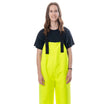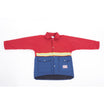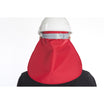Welcome to this comprehensive guide that unpacks the importance of tear-resistant rain gear in the tough working world of construction. As anyone in the field can confirm, construction work involves grappling with multiple hazards, many of which are amplified by inclement weather conditions. With a spectrum of risks from moisture-related concerns to more tangible physical hazards, one crucial line of defense is quality rain gear. Breathing life into the old saying, "there's no such thing as bad weather, only unsuitable clothing," this guide delves into why tear-resistant rain gear can be a game-changer for construction workers in rainy climes.
From evaluating the key features of superior rain gear to providing insights into its maintenance, this guide aims to equip you with everything you need to know about choosing, using, and caring for your tear-resistant rain gear. So, come rain or shine, a construction worker equipped with the right information can keep marching ahead, unhindered and protected every step of the way. It's time to explore everything there is to know about tear-resistant rain gear in the construction industry. Let's dive right in!
Overview of Construction Work Hazards
Working in construction is anything but a walk in the park—it's a multi-faceted industry filled with varying types and levels of risks. Safety is paramount in this line of work, hence a deep understanding of potential hazards is crucial. This section will elucidate the different hazards present in construction work, including weather conditions, physical perils, and moisture-related concerns.
Weather Conditions
The first potential hazard we need to consider is weather conditions. Construction work often takes place outdoors, thus leaving workers susceptible to the elements. Let's consider the following:
- Extreme Heat: Working under the intense summer heat can lead to dehydration, heatstroke, and burns. Wearing appropriate protective equipment and maintaining adequate hydration are essential ways to mediate these risks.
- Cold Weather: Just like extreme heat, winter's cold can be hazardous. Hypothermia and frostbite are real threats to construction workers who need to ply their trade during the colder months.
- Wind: High winds, particularly on high-rise constructions, present a significant risk. They can result in falling debris causing injury, difficulty in handling materials, and increased risk of falls from height.
Physical Hazards
Next, we move onto physical hazards, which are one of the main sources of injuries in construction sites. Potential physical hazards include:
- Slips, Trips, and Falls: These types of incidents can occur virtually anywhere on a construction site. Unsecured ladders, cluttered walkways, and uneven terrain are all potential risk factors.
- Falling Objects: Construction zones are synonymous with high-rise building structures and moving machinery, which pose the risk of falling objects that can cause grave injuries.
- Heavy Machinery Accidents: Operating heavy machinery can pose several risks if not handled correctly. Overturning equipment, colliding with other machinery, or even workers getting hit by these machines are prevalent on construction sites.
Moisture-Related Concerns
Lastly, let's delve into moisture-related concerns. Damp or wet environments can increase the likelihood of slips and falls, while long-term exposure to dampness can lead to respiratory issues caused by mold growth.
To stay safe in the dynamic and fast-paced environment we call a construction site, it's crucial to consider these hazards. It not only helps achieve a healthier work atmosphere, but it also enhances productivity and financial bottom-line, given that accidents and downtime are significantly minimized. Safety should always be the priority, in construction, as in every other industry. Remember to stay updated with the latest safety guidelines, and never underestimate the potential risks. Stick to the adage: “It's better to be safe than sorry.”
Importance of Tear-Resistant Rain Gear
The necessity for tear-resistant rain gear cannot be overstated, particularly for individuals who work in demanding outdoor environments. Tear-resistant rain gear offers a robust solution against harsh weather conditions, maintaining the wearer's comfort and overall productivity. Let's delve into a detailed analysis of why this type of gear has such an integral role in outdoor work scenarios.
Protection from Rain and Moisture
The primary role of rain gear is to shield the wearer from rain and wetness. Traditional rain gear does fulfill this role, but there's a unique advantage to using tear-resistant versions. When speaking about regular rain gear, they may rip or tear, leaving the wearer exposed to the elements. With the tear-resistant varieties, such risks are minimal.
- Showers will not leave you drenched
- Increased protection from other elements such as wind
- No leakage, even in heavy rain
By investing in tear-resistant rain gear, you're ensuring that rain complexities won't slow you down or make your outdoor activities less enjoyable.
Durability Under Heavy Work Conditions
It's a common scenario: your rain gear gets caught on a nail, a corner, or something sharp, and suddenly you're left vulnerable to the weather. This is where tear-resistant rain gear truly comes into play. It is specially designed to withstand rugged working conditions.
- Resistance to abrasion and punctures
- Long-lasting, reducing the need for frequent replacements
- Withstands catering to high-demand tasks
Heavy-duty or not, work needs to go on, and tear-resistant rain gear ensures there's no unexpected interruption in your work flow.
Enhanced Safety and Productivity
Wet conditions can take a toll on an individual's wellbeing, increasing chances of illness and reducing productivity. Tear-resistant rain gear not only safeguards you from the weather, but its sturdy nature reduces the chances of accidental rips, subsequently preventing exposure to cold and rain.
- Limits potential safety hazards
- Increases work productivity
- Reduction in work absenteeism due to weather-related illnesses
Tear-resistant rain gear thus creates a safer and more efficient work environment, propelling the individual and their team towards a smoother route to success.
The importance of tear-resistant rain gear extends beyond mere protection from precipitation. Its ability to provide consistent protection under demanding circumstances and enhance overall productivity demonstrates the value of such gear. Consider upgrading your regular rain gear to a tear-resistant one and experience the proactive difference it brings to your daily life, whether at work or outside of it.
Features of Quality Tear-Resistant Rain Gear
We live in a world where the weather is as unpredictable as it can get. One minute it's sunshine and clear skies, and the next, heavy downpours that leave you soaking wet. With such uncertainties, it's crucial that you invest in the best rain gear that you can find. But not just any rain gear will do – you need tear-resistant rain gear.
Tear-resistant rain gear will brave the storm and emerge unscathed. It's specifically designed to resist scruffs, pulls, and tears. Even when used regularly, they'll hardly show signs of wear and tear. Now the question is, what features should you look for in quality tear-resistant rain gear? Let's explore.
Material Composition
The resistance of your rain gear to tearing is primarily determined by its material composition. The goal is to find materials that offer optimal protection against ripping apart while providing enough comfort to the wearer. The following materials are often incorporated into tear-resistant rain gear:
- Nylon: Nylon is well-loved for its robust nature, great tear resistance, and outstanding durability.
- Polyester: This synthetic fiber is known for its ruggedness, including resistance to most chemicals and environmental conditions. It's a popular choice for top-tier rain gear.
- GORE-TEX: This material stands in a league of its own. It offers excellent water resistance and fantastic breathability, while its rugged construction withstands the chance of tearing.
Weave and Tear Resistance
The weave of the material plays a crucial role in determining tear resistance. A tightly woven material enhances ripstop capabilities. The beauty of tight weaves is that even if a tear does occur, it's less likely to spread, keeping the damage isolated and easily repairable.
Design and Fit
Beyond material and weave, the design and fit of the gear are equally important. Efficient, tear-resistant rain gear should not only keep you dry but also should feel comfortable. An adjustable fit with ample room for movement will reduce the chance of the material tearing under strain.
Above all, remember a quality rain gear effectively serves two main purposes - safeguarding you from the elements and ensuring durability over time. Whether you're tackling the harsh wilderness, commuting to work, or going for a casual hike, arm yourself with quality tear-resistant rain gear that offers substantial protection and longevity. The adventure doesn't have to stop when the rain starts!
Selecting the Right Rain Gear for Construction Work
Constructing buildings, bridges, or roads doesn't stop for a little rain and neither should you. However, it is essential to shield yourself from nature's unpredictable outbursts with appropriate rain gear. Picking the correct gear isn't just about staying dry; it's about your safety, comfort, and productiveness, turning adverse conditions into another productive workday. This comprehensive guide will assist you in choosing the most effective rain gear for construction work.
Identifying Working Conditions
The first step in choosing the right rain gear involves understanding the specific conditions of your work site. Identifying these circumstances can help you make an informed decision about the type of rain gear you'll need.
- Climatic Conditions: Is rainfall frequent, or are rain showers irregular but heavy? These will determine if you need gear for everyday use or for short, intense periods.
- Temperature: If it's usually cold and rainy, opt for rain gear with embedded insulation. On the contrary, hot, humid climates would need gear that is breathable to prevent overheating.
- Physical Demands: High-intensity activities might require lightweight and flexible gear, whereas more stationary work might allow for heavier, more rugged options.
Determining Gear Requirements
Next, consider the specifications of the gear itself based on your job demands. This pertains to the gear's design, safety, and level of comfort.
- Waterproof vs. Water-Resistant: Waterproof gear provides higher protection but may lack breathability. Water-resistant gear, on the other hand, combats light rain while also facilitating air circulation.
- Visibility: For low-light conditions, gear with reflective accents or features can improve safety.
- Comfort and Fit: Ill-fitted gear can hinder movement and decrease productivity. Prioritize adjustable features for a better fit.
Materials and Durability Considerations
The longevity of your gear hinges on the durability of its material. Compromising on this aspect could result in frequent replacements, subsequently affecting both your work and wallet.
Three key considerations are:
- Type of Material: Common choices include PVC, nylon, and Gore-Tex each with varying degrees of water resistance, breathability, and durability.
- Thickness and Layering: Thick, multi-layered gear withstands severe weather but could compromise flexibility.
- Seam Quality: Sealed or welded seams prevent water ingress, imperative for keeping dry.
Remember, the perfect rain gear doesn't exist - it varies according to individual needs and worksite conditions. Investing effort into identifying these factors will pay off in the long run, ensuring your gear enhances, rather than hinders, your work performance. After all, with the right equipment, a little rain can never stand in the way of building remarkable things.
Maintenance and Care of Rain Gear
Maintaining your rain gear in top condition isn't just about keeping dry when the heavens open up; it's also about maximizing the lifespan of your gear. With exposure to harsh weather and normal wear and tear, even the most rugged rain gear can start losing its effectiveness unless properly cared for. This guide covers essential methods to clean, inspect, and replace your rain gear, ensuring it remains effective and lasts long.
Cleaning and Storage
Cleaning rain gear isn't all about aesthetics. Dirt and oil can wear down the material, reducing its waterproof capacity. Here's how to keep it clean:
- Gentle Cleaning: Use a mild detergent or a specialized tech wash for synthetic materials. Avoid bleach or fabric softener, as they can damage the waterproof coating.
- Air Dry: Tumble drying can ruin the waterproof layer. Instead, let the rain gear air dry, but avoid direct sunlight.
When it comes to storage, it's best to hang rain gear in a cool, dry place. Folding or compressing it could lead to wrinkles that compromise the durability and functionality of the garment.
Regular Inspection
Regularly inspecting rain gear not only keeps you dry but also extends the lifespan of your gear. Keep an eye out for the following signs of wear and tear:
- Leaking Seams: Compromised seams allow water to sneak in. Luckily, some seam sealers can quickly fix minor issues.
- Worn-Out DWR: Durable Water Repellent (DWR) treatment makes rain droplets bead up and roll off the fabric. If water no longer beads, it's a sign the DWR coating needs refreshing.
By consistently looking for these potential issues, you can address them before they become more severe, thereby extending the life of your gear.
Proper Replacement
There will come a time when no amount of care and maintenance will salvage your rain gear and the wisest choice would be to replace it. Understanding when to replace your gear can help protect you from harsh weather elements and potentially save you money in the long run. Generally, if the fabric is flaking, the waterproof layer is peeling, or the gear no longer keeps you dry even after reapplying DWR, it's time for a replacement.
Maintaining rain gear involves more than just post-trip cleaning. It requires regular inspections and understanding when replacement is necessary. By following the maintenance steps discussed above, you increase your rain gear's effectiveness and prolong its life, ensuring you remain dry and comfortable no matter the weather's antics.
Conclusion
The essence of appropriate and durable rain gear in construction work cannot be overstated. From providing crucial protection against harsh weather to ensuring long-term durability under demanding work conditions - investing in high-quality, tear-resistant rain gear is not just about the expense; it's about safety, productivity, and overall well-being.
As we carefully wade through comprehensive considerations like material composition, gear requirements, and ongoing maintenance practices, the path to selecting the right rain gear becomes unambiguous. Yet, like most things, not all rain gear is created equal.
For those in search of the ideal balance between protection, comfort, and durability, Hurricane Raingear offers an array of handcrafted rain gear options specifically designed to withstand the punishing demands of construction work. Embracing the resiliency of 100% North-American-Made materials, their products illustrate a supreme understanding of on-field needs and continued dedication to customer satisfaction.
By recognizing the importance of tear-resistant rain gear and making informed choices, we can establish a safer and more efficient construction environment despite the unpredictability of weather conditions. With the right rain gear, it becomes not about surviving the elements, but thriving in them. So make your choice confidently- let the rain come down; you're more than ready.
Frequently Asked Questions
-
Why is tear-resistance important in rain gear for construction work?
Tear-resistance is important in rain gear for construction work because it ensures durability and longevity. Construction sites can be harsh environments with rough surfaces and sharp objects. Tear-resistant rain gear can withstand these conditions, preventing tears and ensuring the gear remains functional and protective.
-
What materials are commonly used in tear-resistant rain gear for construction work?
Common materials used in tear-resistant rain gear for construction work include nylon, polyester, PVC, and Gore-Tex. These materials are known for their strength, resistance to tears, and waterproof properties that provide optimal protection against the rain.
-
Is tear-resistance the only important factor to consider in rain gear for construction work?
No, tear-resistance is just one important factor to consider. Other factors include waterproofness, breathability, comfort, visibility, and the presence of additional features such as reflective strips, adjustable hoods, and pockets for storage.
-
How can tear-resistant rain gear improve safety in construction work?
Tear-resistant rain gear improves safety in construction work by offering reliable protection against the rain, preventing workers from getting wet and cold, which can lead to discomfort, distraction, and potentially accidents. It also helps to maintain the integrity of personal protective equipment (PPE) worn underneath.
-
Are tear-resistant rain gear options available for different seasons in construction work?
Yes, there are tear-resistant rain gear options available for different seasons in construction work. Some gear is designed for warmer weather and is more lightweight and breathable, while others are insulated for colder conditions. It's important to choose gear that suits the specific weather conditions and work environment.





















Leave a comment
This site is protected by hCaptcha and the hCaptcha Privacy Policy and Terms of Service apply.